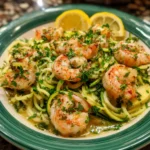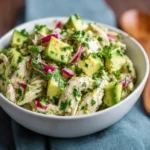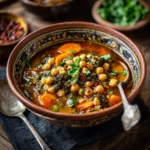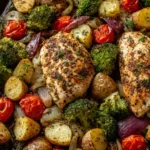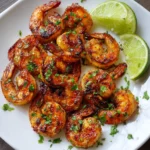Garlic Butter Shrimp Pasta: A Creamy, Flavorful Delight
If you’re craving a restaurant-quality meal that’s quick to prepare and packed with rich, savory flavors, look no further than Garlic Butter Shrimp Pasta. This dish combines plump, juicy shrimp with al dente pasta in a luxurious garlic butter sauce that’s both simple and elegant. Whether it’s a weeknight dinner or an impromptu date night at home, this recipe delivers gourmet taste with minimal effort. The harmonious blend of fresh garlic, aromatic herbs, creamy butter, and perfectly cooked seafood makes this dish a favorite among seafood lovers and pasta enthusiasts alike.
The History of Garlic Butter Shrimp Pasta
While there isn’t a single documented origin for Garlic Butter Shrimp Pasta, its roots can be traced back to classic Italian and French culinary traditions where butter, garlic, and seafood have long been celebrated ingredients. In Italy, dishes like spaghetti aglio e olio showcase the power of garlic and olive oil, while French cuisine often features delicate seafood preparations in rich butter sauces such as beurre blanc or beurre monté. Over time, these influences merged in American kitchens, particularly along coastal regions where fresh shrimp was abundant.
In the mid-20th century, as international travel and global food trends gained popularity, home cooks began experimenting by combining elements from different cuisines. The result? Dishes like Garlic Butter Shrimp Pasta emerged—simple yet indulgent meals that highlighted fresh ingredients and bold flavors. Today, it’s a staple on many Italian-American menus and has become a beloved comfort dish around the world, frequently featured in cooking blogs, food networks, and family dinner tables.
Ingredients Breakdown: What Makes This Dish Shine?
The magic of Garlic Butter Shrimp Pasta lies in its simplicity and quality of ingredients. Each component plays a crucial role in building layers of flavor and texture:
- Shrimp: Large or jumbo shrimp (peeled and deveined) are ideal because they hold up well during cooking and offer a satisfying bite. Fresh or high-quality frozen shrimp work equally well.
- Pasta: Linguine is traditionally used due to its ability to capture sauce, but fettuccine, spaghetti, or even angel hair can be substituted based on preference.
- Butter: Unsalted butter allows better control over seasoning and provides a rich, velvety base for the sauce. For extra depth, some recipes use a combination of butter and olive oil.
- Garlic: Freshly minced garlic is non-negotiable—it gives the dish its signature aroma and pungent sweetness when sautéed gently in butter.
- White Wine: A dry white wine like Pinot Grigio or Sauvignon Blanc adds acidity and complexity, helping to deglaze the pan and lift flavorful browned bits.
- Lemon Juice: Brightens the dish and balances the richness of the butter, adding a refreshing zing.
- Heavy Cream (optional): Some variations include a splash of cream for a silkier, more decadent sauce.
- Herbs: Fresh parsley is most commonly used, but basil, chives, or thyme can also enhance the flavor profile.
- Cheese: Grated Parmesan or Pecorino Romano adds umami and a subtle salty tang.
- Seasonings: Red pepper flakes bring gentle heat, while salt and black pepper round out the overall taste.
Using fresh, high-quality ingredients ensures the best results. Avoid pre-cooked shrimp if possible, as they tend to become rubbery when reheated. Likewise, freshly grated cheese melts better and tastes superior to pre-grated varieties.
Step-by-Step Recipe: How to Make Perfect Garlic Butter Shrimp Pasta
Follow this detailed guide to create a flawless Garlic Butter Shrimp Pasta every time:
- Cook the Pasta: Bring a large pot of salted water to a boil (use about 1 tablespoon of salt per quart of water). Add 8–12 oz of linguine or your preferred pasta and cook according to package instructions until al dente. Reserve ½ cup of pasta water before draining. Do not rinse the pasta—starchy water helps bind the sauce.
- Prepare the Shrimp: Pat 1 pound of raw, peeled, and deveined shrimp dry with paper towels. Season lightly with salt, black pepper, and a pinch of red pepper flakes. Set aside.
- Sauté the Garlic: In a large skillet or sauté pan, melt 4 tablespoons of unsalted butter over medium heat. Add 4–6 cloves of minced garlic and cook for about 1 minute, stirring constantly, until fragrant but not browned (burnt garlic turns bitter).
- Cook the Shrimp: Increase heat to medium-high. Add the seasoned shrimp in a single layer. Cook for 1–2 minutes per side, just until pink and opaque. Remove shrimp from the pan and set aside—do not overcook.
- Build the Sauce: In the same pan, pour in ¼ cup of dry white wine to deglaze. Scrape up any browned bits from the bottom of the pan using a wooden spoon. Let the wine simmer for 2–3 minutes until reduced by half.
- Add Cream (Optional): Stir in ¼ cup of heavy cream if using, then return the cooked shrimp to the pan. Gently toss to coat in the sauce.
- Incorporate the Pasta: Add the drained pasta directly into the skillet. Toss everything together, adding reserved pasta water a few tablespoons at a time to help emulsify the sauce and ensure even coating.
- Finish with Flavor: Stir in the juice of half a lemon, 2 tablespoons of chopped fresh parsley, and ¼ cup of grated Parmesan cheese. Adjust seasoning with additional salt, pepper, or red pepper flakes to taste.
- Serve Immediately: Plate the pasta hot, garnishing with extra parsley, a lemon wedge, and a sprinkle of Parmesan. Drizzle with a touch of olive oil for added shine if desired.
Pro Tips for Success
- Don’t Overcook the Shrimp: Shrimp cook very quickly and will continue to cook slightly after removal from heat. Overcooking leads to tough, chewy texture. Remove them from the pan as soon as they turn pink and curl into a “C” shape.
- Use Fresh Garlic: Pre-minced garlic from jars lacks freshness and can have a metallic taste. Mince your own for optimal flavor.
- Reserve Pasta Water: The starchy liquid acts as a natural thickener and binder for the sauce. Never skip this step!
- Brown the Butter (Optional Upgrade): For a nuttier, deeper flavor, try browning the butter slightly before adding garlic. Watch carefully to prevent burning.
- Prep Ahead: Mince garlic, chop herbs, and measure ingredients before starting. This dish comes together fast, so mise en place is key.
- Balance Acidity: Taste before serving. If the dish feels too rich, add a bit more lemon juice. If too sharp, swirl in another pat of butter.
Variations and Customizations
One of the best things about Garlic Butter Shrimp Pasta is how easily it adapts to personal preferences and dietary needs. Here are some creative twists:
- Spicy Kick: Double the red pepper flakes or add a dash of cayenne or sriracha for a fiery version.
- Creamy Version: Add ½ cup of heavy cream or mascarpone cheese for a richer, more luxurious sauce.
- Dairy-Free: Substitute butter with vegan butter or olive oil, and omit cheese or use nutritional yeast for a cheesy flavor.
- Gluten-Free: Use gluten-free pasta made from rice, corn, or quinoa. Ensure all other ingredients are certified GF.
- Add Vegetables: Sauté spinach, cherry tomatoes, asparagus, mushrooms, or zucchini alongside the garlic for added nutrition and color.
- Protein Swap: Replace shrimp with scallops, chicken, or even tofu for a vegetarian option.
- Herb Variations: Try tarragon for a French twist, dill for a Scandinavian flair, or cilantro for a bright, citrusy note.
- Wine-Free: Skip the wine and use low-sodium chicken or vegetable broth instead, plus a splash of white wine vinegar for acidity.
- Lemon Butter Only: Omit garlic for a milder Lemon Butter Shrimp Pasta—perfect for sensitive palates.
- Alfredo Fusion: Blend in Alfredo sauce for a hybrid Garlic Butter Shrimp Alfredo Pasta.
Health Considerations and Nutritional Value
Garlic Butter Shrimp Pasta can be part of a balanced diet when enjoyed in moderation. Here’s a breakdown of its nutritional components:
- Shrimp: Low in calories and fat, high in protein, and rich in selenium, vitamin B12, iodine, and omega-3 fatty acids. However, shrimp contain dietary cholesterol, though recent studies suggest this has less impact on blood cholesterol than once believed.
- Butter: High in saturated fat and calories. Consider using grass-fed butter for higher nutrient content or substituting part with heart-healthy olive oil.
- Pasta: Provides carbohydrates for energy. Whole wheat or legume-based pastas offer more fiber and protein.
- Garlic: Known for immune-boosting and anti-inflammatory properties. Contains allicin, which may support cardiovascular health.
- Lemon Juice: Adds vitamin C and antioxidants without extra calories.
- Wine: In small amounts, contributes negligible alcohol content after cooking and offers polyphenols.
Nutrition Estimate (per serving, serves 4):
- Calories: ~500–650 kcal (depending on cream and cheese usage)
- Protein: 25–30g
- Fat: 20–30g (mostly from butter and optional cream)
- Carbohydrates: 50–60g
- Fiber: 2–4g
- Sodium: 600–900mg (adjust by reducing added salt)
To make a healthier version:
- Use whole grain or chickpea pasta.
- Reduce butter to 2 tablespoons and replace with olive oil.
- Omit heavy cream or replace with Greek yogurt.
- Increase vegetables to boost fiber and volume.
- Serve with a side salad for a more balanced meal.
Ingredients
- 8–12 oz linguine (or pasta of choice)
- 1 lb large shrimp, peeled and deveined
- 4 tbsp unsalted butter
- 4–6 cloves garlic, minced
- ¼ cup dry white wine (e.g., Pinot Grigio)
- ¼ cup heavy cream (optional)
- Juice of ½ lemon
- ¼ cup grated Parmesan cheese
- 2 tbsp fresh parsley, finely chopped
- ½ tsp red pepper flakes (adjust to taste)
- Salt and freshly ground black pepper, to taste
- Reserved pasta water (about ½ cup)
- Optional: 1 tbsp olive oil, lemon zest, extra Parmesan for garnish
Directions
- Bring a large pot of salted water to a boil. Add pasta and cook until al dente. Reserve ½ cup of pasta water, then drain and set aside.
- Pat shrimp dry and season with salt, pepper, and red pepper flakes.
- In a large skillet over medium heat, melt butter. Add minced garlic and sauté for 1 minute until fragrant.
- Increase heat to medium-high. Add shrimp in a single layer and cook 1–2 minutes per side until pink and opaque. Transfer to a plate.
- Pour white wine into the skillet, scraping up browned bits. Simmer 2–3 minutes until reduced by half.
- If using, stir in heavy cream and return shrimp to the pan. Warm through.
- Add cooked pasta to the skillet. Toss to combine, adding reserved pasta water gradually to create a silky sauce.
- Stir in lemon juice, parsley, and Parmesan. Adjust seasoning with salt, pepper, or more red pepper flakes.
- Serve immediately, garnished with extra parsley, lemon wedges, and a sprinkle of Parmesan.
Frequently Asked Questions (FAQ)
Can I use frozen shrimp?
Yes, but thaw them first in cold water or overnight in the refrigerator. Pat dry thoroughly before cooking to prevent steaming.
What if I don’t have white wine?
Substitute with chicken or vegetable broth and a splash of white wine vinegar or lemon juice for acidity.
Can I make this ahead of time?
Best served fresh. However, you can prep ingredients in advance. Reheat gently with a splash of water or broth to revive the sauce.
Why is my sauce separating?
This can happen if the heat is too high or if cold cream is added abruptly. Keep heat moderate and temper dairy by warming it slightly before stirring in.
Is this dish keto-friendly?
Traditional versions are not, due to pasta. Use zucchini noodles (zoodles), shirataki noodles, or spaghetti squash for a low-carb alternative.
How do I store leftovers?
Store in an airtight container in the fridge for up to 2 days. Reheat gently on the stove with a little water to loosen the sauce. Freezing is not recommended due to texture changes in shrimp and cream.
Can I use margarine instead of butter?
Not recommended—margarine has a higher water content and can alter flavor and texture. Stick to real butter for best results.
What pasta works best?
Linguine, fettuccine, and spaghetti are top choices. Short pastas like penne or rigatoni also work well, especially with added vegetables.
Can I double the recipe?
Yes, but cook shrimp in batches to avoid overcrowding the pan, which leads to steaming instead of searing.
Is this dish safe for shellfish allergies?
Absolutely not. This recipe contains shrimp and should be avoided by anyone with crustacean allergies.
Summary
Garlic Butter Shrimp Pasta is a sumptuous, quick-cooking dish that brings together tender shrimp, al dente pasta, and a rich, aromatic garlic butter sauce. With endless customization options and restaurant-worthy results, it’s perfect for both everyday dinners and special occasions.


